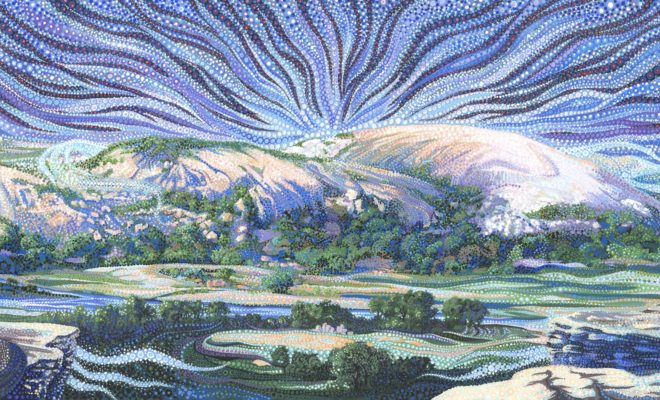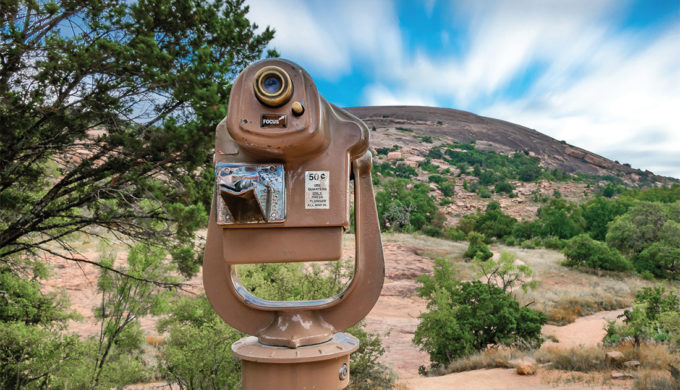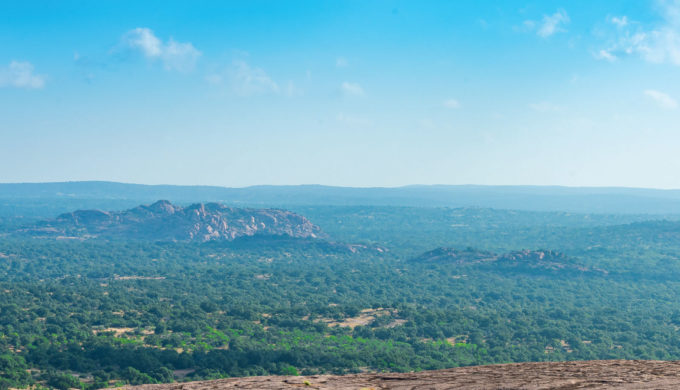The Comanche only came to dominate the area in the mid-1700s, and they conflicted with the Spanish frequently after destroying the mission Santa Cruz de San Saba in 1758. The colony of Friedrichsburg, founded in 1846 by German immigrants from the area of Montabaur, was originally to be established north of the Llano River, but its present location was settled instead because of the hostility of the Comanche. One of the more famous legends at E-Rock is of a battle between Texas Ranger John Coffee (Jack) Hays and Indians in the fall of 1841. Hays and his company of Rangers were surveying near Crabapple Creek when he was cut off by a band of Comanche raiders and took refuge on the summit of Enchanted Rock. Legend has it that he held off the Comanche for three hours until being rescued by his fellow Rangers, or perhaps when the Indians tired of the fight. This story has been considered legendary because there is little evidence to support it, but Former Texas Ranger Foundation President Joe Davis told me that Hays once commissioned a painting depicting the skirmish. This painting eventually made its way the Official Texas Ranger Hall of Fame and Museum in Waco and can be seen on their website. The depiction of the background in the painting does not perfectly represent Enchanted Rock, but this likely came from the imagination of the painter. Hays was a Texas Ranger for only six years before he moved west, became Sheriff of San Francisco County in 1850, and founded the city of Oakland. A historical marker about the skirmish was placed on Enchanted Rock in 1936, and although this plaque is no longer on the Rock, the story is told on a marker along FM 965 where it joins US Hwy 16 northeast of the park.
 Enchanted Rock Dreamscape by Ira Kennedy
Enchanted Rock Dreamscape by Ira Kennedy
Magazine Articles
The Mystery and Magic of Enchanted Rock: A Texas Landmark

Photo provided by Juan Santillan
There are other legends as well. One is that a tribe of brave warriors was attacked by another tribe with their last defense on Enchanted Rock. All the tribe were killed, and their ghosts haunt the area to this day. Another is that an Indian chief sacrificed his daughter on the Rock, and now walks the summit forever as punishment. Another story is that of a white woman, escaped from her Indian captors, whose screams are still heard at night. There are stories of the Rock creaking at night, presumably from the cooling of rocks heated by sunlight during the day. Early reports of the Rock said that it was made of platinum, or that there was a spring on top which gushed out water falling down all its sides making it look like metal. Various posts on the internet claim that after a rainstorm the surface of the Rock glows with a green hue two meters above the surface, or that the Rock glows with a green-blue hue right at sunrise and sunset. I spoke with people who live or have lived in the park over the last 50 years, climbers who have regularly been in the park at sunrise and sunset for those same years, and park staff, and none has heard ever heard any sounds, or seen glowing around the Rock. Native Americans considered the place either haunted or magical or sacred, which is why the place is called Enchanted Rock. It would not be fair to say these sounds and visual effects have never happened, but I can say they have not been noted of late.
However, local artist Ira Kennedy, who has a long connection with the park, told me some other stories. Ira lived very close to the park for some years and was a writer for the Highlander newspaper in Marble Falls. In August of 1987, he was given a lead that something big was about to happen at Enchanted Rock. As a part of a celestial event called the “Harmonic Convergence,” E-Rock was one of many places around the world which was presumed to be a special place, and over 7,000 people converged on the park (these days the most people you will find in the park on any given day is less than 2,000). You can find the full story on his website (www.irakennedy.com) as well as his book “The History of Enchanted Rock.”

Photo provided by Juan Santillan
Ira has many stories to tell; I’ve always suspected that his Native American parentage gives him an edge in connecting to the spirit world, something clearly represented in his art. Ira told me three stories: one night when he lived close to the park he heard Indian drums, when there were clearly no other people around. Another time he was walking in the park when his companion asked him about the drums she was hearing; again, no drummers present. And years ago, when the power line through the park was being built, an engineer on-site asked the lineman he was working with, “What happened to the Indians who used to live here.” The lineman, an Indian, replied, “They’re still here. You don’t hear the drums?”
When you find yourself on a quiet trail, perhaps on the loop trail through the less often visited places… Stop. Stand still and give all your attention to the place where you are. Look up at the vulture which has come to take a closer look at you. Notice the colors of the grass, the prickly pear tunas, the flowers. Smell the air moving around you. Live with the silence. Listen closely. Can you hear the Indian drums?
Originally published in the Fall Issue of Heart of Texas Magazine.

